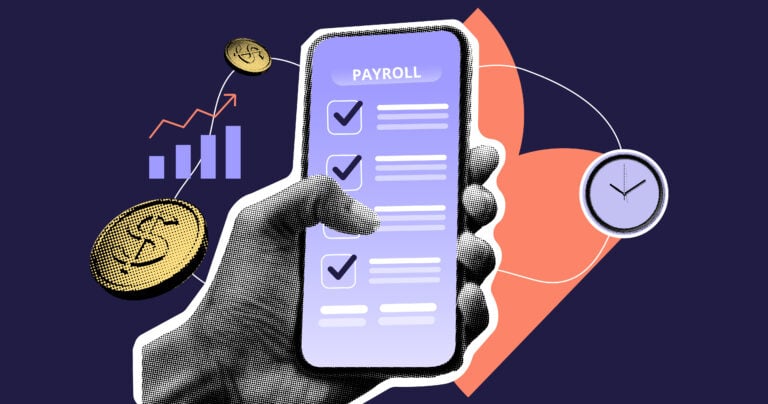Getting the balance between providing enough PTO so that your employees are satisfied and also ensuring they’re spending enough time at work can be tricky. The first step in supporting employees in finding this balance is by creating a great PTO policy.
When writing your company PTO policy, you will probably have lots of questions. This article will discuss how to create a time off policy, what a standard PTO policy for small businesses looks like, different PTO policies, and strong company PTO policy examples.
What Is PTO?
Paid Time off (PTO) is a benefit where employees are paid for the time they aren’t at work. Different types of PTO may include paid vacation time, paid bereavement leave, or any other type of paid personal leave.
PTO is considered one of the most important benefits to employees; In one survey, 80% of employees said they’d be drawn to a role with lots of PTO. In addition, 78% of managers say that teams who use their PTO are more engaged than those who don’t and 81% of managers agree that an ample PTO allowance reduces burnout among teams. Offering PTO keeps your teams engaged with your business and—therefore—more productive.
You can learn more about PTO and how it is accrued here.
Pro Tip
Take advantage of a time off management app, like Connecteam, to easily manage all things PTO from your desktop, tablet, or phone. Employees can request time off directly from the app, and you can track balances, create time off policies, and view all leave requests in a centralized location.
Get started with Connecteam for free today!
Benefits of PTO
Offering employees paid time off is not only good for their mental health, but it creates a more productive workplace and increases your bottom line.
Here’s three primary benefits of PTO to your business:
- Gives your company a competitive advantage: PTO isn’t required by law, so it’s considered a benefit. Offering a time off policy makes your business more appealing and attracts employees to want to work there.
- Increases employee retention: A flexible PTO policy leads to higher rates of employee satisfaction and happiness, which helps retain quality employees.
- Prevents burnout: Everyone needs time to rest and recharge, and offering PTO allows your employees to do so. They can take paid time off without having to worry about losing income and come back to work feeling refreshed.
What Is a Standard Company PTO Policy?
A paid time off policy outlines the nature of the PTO available to employees in your organization. It typically includes how much PTO employees are entitled to, how their PTO is accrued, how vacation pay works, and information about how employees can request their PTO.
A good PTO policy is clearly written and accessible to all colleagues. Talking through the PTO policy should be part of your employee onboarding process, so employees understand their entitlement from day one. Consider including the standard company PTO policy in the employee handbook so it’s always easily available.
This Might Interest You
Check out this article on how to create a policy and procedure manual for your business.
Is PTO required by law?
In most cases, there is no legal requirement to provide employees with PTO. However, offering paid time off as a benefit—even when you have no legal responsibility to do so—builds strong workplace relationships and will ultimately increase employee engagement.
You legally need to provide time off if an employee has a chronically ill family member and has worked a minimum of 1,250 hours for you over the last 12 months. If this is the case, they will be entitled to unpaid leave under the Family and Medical Leave Act (FMLA) to care for this family member. However, you can choose to pay this employee to support them.
You can also read our in-depth guide on average vacation days per year guide.
This Might Interest You
→ Check out our article on PTO Payout Laws By State to better understand what’s required of your company.
Types of PTO Policies
There are several types of PTO policies, and they all have their strengths and weaknesses. When selecting a standard PTO policy for your small business, it’s important that you first consider which policy best suits your employee’s and business needs. Consider running a survey of employees to understand what types of PTO they use most often and what kind of policy they might like to see to help shape your decision.
Accrual
An accrual policy is the most common type of PTO policy. It is popular with smaller businesses and startups as it allows employees to accumulate their PTO allowance throughout the year instead of offering all PTO in one lump sum. This helps smaller businesses manage the cost of their PTO and allows employees to take sufficient breaks throughout the year as they consistently accrue PTO.
With accrued leave, if an employee chooses to quit the business, this policy means they would not owe large amounts of PTO back to the company. Employees will only be able to take the paid time off that they are entitled to.
If you decide you use an accrued time-off policy, here are some things you should consider.
- How will your PTO year run? Will it Run from January to January or in line with the financial year? Whichever option you decide on, be sure to include this information in your PTO policy to prevent employees from overtaking their PTO by mistake.
- At what rate do employees accrue their PTO? This depends on how many pay periods you have per month. For example, a business with two pay periods per month allows employees to accrue smaller amounts of PTO quicker than businesses with one pay period per month.
- Will you allow employees to carry over accrued PTO from previous vacation years? You have no legal requirement to do this, and many employers operate a use-it-or-lose-it policy. However, there may be benefits to small businesses or startups that allow employees to carry over paid vacation days. This policy will enable employees to work intensely for an entire year and take longer, more relaxing breaks in the second year when a startup may have employed more staff or their initial growth period may have plateaued. You should also consider implementing a PTO accrual cap, which limits how much PTO employees can accrue during certain periods.
Banked PTO
Banked PTO policies are popular among large, private-sector organizations where there tends to be a lot of trust between managers and employees. A Banked PTO policy is similar to an accrual policy in that PTO is slowly accrued throughout the year.
The main difference is that the company grants employees a certain amount of PTO at the beginning of the year as a lump sum—for example, 20% of their PTO allowance—and allows the employee to accrue the remaining 80% as the year progresses. This “bank” of PTO is helpful as it allows employees to deal with any personal emergencies that may arise before they’ve had a chance to accrue any PTO.
Paying an employee’s PTO forward—and in good faith—builds a sense of trust between employers and employees, which is beneficial for team morale. However, this policy can cause issues for employers as you are contractually obligated to pay any PTO the employee is eligible for should the employee leave the business. Paying this PTO in a lump sum may be out of a smaller business or start-up’s budget.
If you decide you use this policy, these are some of the things you should consider.
- How much PTO will you allocate at the beginning of the year? As this PTO is intended for any personal emergencies or unplanned sickness the employee may experience, it is recommended that you keep this percentage to a minimum—ideally below 20%. If an employee were to leave partway through the year, this would help to keep the payout costs relatively low.
- How will employees request their PTO? Larger companies may struggle with PTO requests as employees usually want similar time off—i.e., around the holidays or sporting events. Will you operate on a first-come-first-serve basis or have a priority system—for example, based on seniority? It’s a good idea to include how PTO is approved in your policy, so employees know where they stand.
Try the #1 Tool for Managing Time Off!
Say goodbye to calculators, paper-based calendars, and guesswork with Connecteam’s all-in-one time management software.
Unlimited PTO
Unlimited PTO policies are popular among tech, social media, and engineering companies. With this policy, employees can—in theory—take as much PTO as they like whenever they like throughout the year. However, an employer usually will set boundaries for this policy to ensure employees have enough time in the business to do their jobs well.
This policy allows employees to balance their personal and work lives and it can also help to attract and retain talented employees to your organization. Many leading tech companies—such as Google and Meta—offer this type of PTO policy.
If you decide you use this policy, here are some points you should consider.
- What is the upper limit of your standard company PTO policy? Be sure to set an upper limit on the amount of PTO employees can take. While the point of an unlimited policy is that employees can take as much time as they need, you want to ensure that employees have adequate time in the business to do their job well.
This will look different for every company – talk to your employees to understand how they feel about an unlimited time off policy. Their guidance will help you set limitations on your unlimited PTO policy.
- The lower limit of your PTO policy. Sometimes, employers with unlimited PTO policies find that employees are so worried about taking too much PTO that they end up not taking any. Employees say this is because they are concerned that taking an excess of PTO will make them look lazy or unmotivated.
Setting guidelines for the minimum amount of PTO you expect employees to take can help mitigate these concerns. For example, you could require that your employees take a minimum of 2 weeks PTO and a maximum of 12 weeks of PTO per year.
How to Write a Standard PTO Policy for Small Business
Once you have considered what type of PTO policy would be best, it’s time to write it. We recommend tackling the policy section by section. You should also run each section by your managers and HR department after writing it to get their input.
→ Check out Connecteam’s free PTO policy template to create a customized policy both you and your employees will be happy with.
Section 1: Introduction
This section should include an introductory paragraph outlining what employees will find in the PTO policy. You may find it easier to write this section after you have completed the rest of the policy, as an introduction is often the most challenging part to write without first writing the contents.
Include an introduction to the policy, a table of contents, page numbers, and the last revision date.
Be sure to include a few lines about your employee PTO tracking software and provide details of how your team can access it.
Section 2: Scope
In this section, you should describe what the policy hopes to achieve. For example, “This policy will ensure all employees are aligned on how much PTO they are eligible for, how they can apply for PTO, and who will approve their PTO requests. Through this, we are creating a fair and measurable process for all employees.”
Section 3: Practicalities
This section should include the practicalities of your new policy.
- How much PTO can employees take?
- What kind of policy are you using, and how this impacts employees
- How employees can apply for PTO
- Who will approve their PTO requests
- The criteria for FMLA
- What happens if employees take too much PTO
- What happens if they leave the business owing PTO?
You should explain this in plain language and use plenty of examples to help illustrate your point. Remember, this may be your employee’s first job, so explaining the process in language that’s comfortable to them with clear examples will make them feel more confident in your standard company PTO policy.
Avoid phrases like, “You will accrue PTO at a constant rate throughout the year.” Instead, try “You will accrue 4 hours of PTO for every pay period worked”.
Keep your language light and positive, use flow charts for complicated processes and try to avoid corporate jargon—show your employee you’re on their side.
Section 4: Limitations
In this section, you should set out your policy’s limitations. This is especially important if you are working with an unlimited or banked PTO policy where the limits need to be specified.
Be sure to include upper and lower limits of sick days and personal days per year your employees can take and what the consequences may be if employees overtake their allowance. Again, keep your tone light and positive. The purpose of this section isn’t to intimidate employees but to help them understand your PTO process.
Use precise language and lots of examples to illustrate your point. A policy that sounds very professional but is unreadable to your employees is of no use to anyone.
Section 5: Conclusions
In this final section, you should specify any important information that hasn’t fallen in any of the above sections. Let employees know that the policy will be regularly updated in line with any new legislation and that the policy is readily available to employees at all times.
If your employee has questions, invite them to contact their manager or your HR department to discuss their queries.
Implementing a clear and comprehensive Paid Time Off (PTO) policy is essential for small businesses to ensure employees understand their entitlements and procedures for requesting time off. For detailed guidance on creating an effective PTO policy tailored to your business needs, refer to our standard PTO policy guide for small businesses.
Conclusion
Creating a comprehensive PTO policy is crucial for small businesses to strike the right balance between employee satisfaction and productivity. A well-designed PTO policy offers numerous benefits, including a competitive advantage in attracting and retaining talent, preventing burnout, and fostering a more productive work environment.
Small businesses have the flexibility to choose from different types of policies, such as accrual, banked PTO, or unlimited PTO, depending on their specific needs and employee preferences. It’s important to carefully consider the implications of each policy type and align them with your business goals.
To streamline and simplify PTO management, we recommend using a dedicated time off management app. With Connecteam, you can effortlessly track PTO balances, establish policies, and handle all leave requests from a centralized platform.
Optimize your company’s PTO management and empower your employees to enjoy well-deserved time off while maintaining productivity.
Get started with Connecteam for free today and revolutionize your company’s PTO management!
The #1 Employee Management App
Keep your team on track by managing time off and sick days with Connecteam. Try it for free today. No credit card required.



